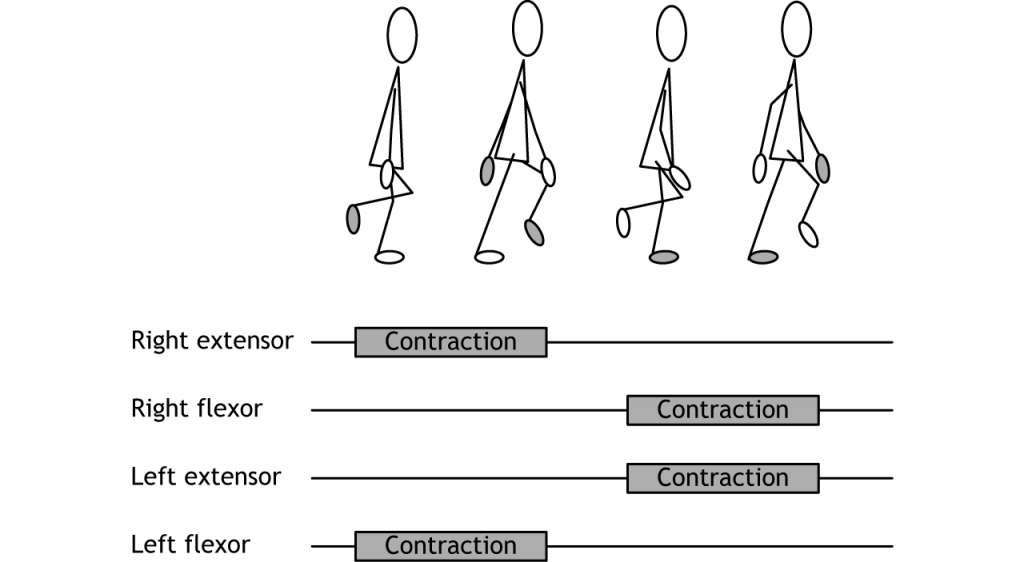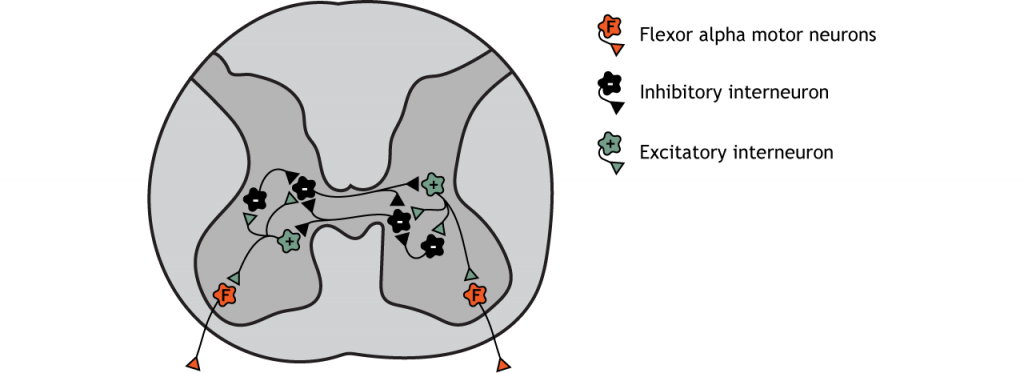42 Central Pattern Generators
Central pattern generators (CPGs) are networks of cells that are capable of producing intrinsic motor responses even in the absence of sensory or brain inputs. These motor responses are usually well-rehearsed, repetitive, and happen at the unconscious level, meaning that certain behavioral outputs can be performed independently of signals upstream in the motor cortex.
CPGs have been observed in several organisms, ranging from insects, crayfish, birds, and mammals including humans, hinting that their evolution was highly adaptive for survival. Imagine how difficult it would be to survive if every breath required a conscious thought! The CPG is not a standalone driver of motor activity, however. The circuits receive signals from higher brain areas which can modify their characteristics. Imagine that you want to consciously hold your breath, or intentionally walk in some unusual or goofy way. In both cases, the descending signals from the brain are able to override the output motor command pattern that the CPG normally produces. Once you stop intentionally changing your motor behavior, the muscles return to their normal activity in response to CPG output.
Central Pattern Generators in Different Species
Many earlier studies of spinal cord CPGs were conducted in different animal groups with unique locomotor patterns. Mollusks have crawling activity that is rhythmic, fish swim by sending alternative patterns of muscle activity through their body, and birds fly by rhythmic flapping of their wings.
In mammals, spinal CPGs were demonstrated in cats with a thoracic-level spinal cord transection. Following this surgery, the signals from the brain were unable to be communicated down to the hind legs, eliminating voluntary movement. They exhibited weakened muscular power, but were still able to stand for short times. If their front paws were put onto a stable platform while their hindlegs were put on a moving treadmill, the cat would involuntarily walk to keep up.
Humans also have CPGs for movement. One remarkable study looked at 37-year-old man who had injured his spinal cord in a football accident as a young man. His injury was at the level of C5, resulting in complete paralysis and a loss of sensation from the neck down. Over the following years, he gradually recovered a small amount of function. Fine manipulation skills and bladder bowel control never recovered, and he had not walked unassisted for ten years, experiencing tremendous weakness after taking a few steps. Just days after beginning a physical therapy regimen consisting of assisted upright walking, upon lying down, the man reported alternating muscle flexion and relaxation of the hips, knees, and ankles similar to the pattern of activity seen in locomotion. He was unable to voluntarily stop these motions, and could only get some rest by turning to the side. This muscle activity was smooth and rhythmic, as would be seen in a healthy person walking.
Locomotion
Some example motor responses driven by CPGs include diaphragm movement (respiration), alternating leg swinging and foot flexing (walking), and the progressive contraction of up to 25 pairs of muscles in the tongue and mouth (swallowing). Some CPGs are located in the brain stem (respiration) and others throughout the spinal cord (locomotion). Locomotion is one example of a basic, rhythmic movement that requires coordination of a number of muscle groups to work properly.

Activity of extensor and flexor muscles in both legs must be coordinated to allow smooth locomotion without falling. These rhythmical movements are controlled at the level of the spinal cord by circuits called central pattern generators. The spinal cord has circuitry that, in the case of walking, moves the legs in opposite patterns. When one leg is lifting up to move forward, the other leg is stable, touching the ground.

Spinal Circuitry
The control of this system has multiple levels. Neurons themselves may have pacemaker properties that allow for a continuous cycle of depolarization and repolarization. These neurons are then located within multi-cell circuits involving a collection of excitatory and inhibitory interneurons that results in reciprocal inhibition of contralateral muscles. Additional networks of spinal interneurons would cause reciprocal inhibition of ipsilateral antagonistic muscles.

Although the spinal cord is able to control these movements on its own, there is input from both the brainstem and sensory neurons which can have an effect on modulating the pattern of neuronal activity in the spinal cord. For example, when an animal needs to slow down, speed up, or turn away from a danger, for example, those inputs can alter the spinal cord circuit.
Key Takeaways
- Central pattern generators are circuits in the spinal cord that control repetitive, consistent movements like walking.
Test Yourself!
Attributions
Portions of this chapter were remixed and revised from the following sources:
- Foundations of Neuroscience by Casey Henley. The original work is licensed under a Creative Commons Attribution-NonCommercial-ShareAlike 4.0 International License
- Open Neuroscience Initiative by Austin Lim. The original work is licensed under a Creative Commons Attribution-NonCommercial 4.0 International License.
Media Attributions
- WalkingCycle © Casey Henley adapted by Valerie Hedges is licensed under a CC BY-NC-SA (Attribution NonCommercial ShareAlike) license
- Walking Cycle Muscle Activation © Casey Henley adapted by Valerie Hedges is licensed under a CC BY-NC-SA (Attribution NonCommercial ShareAlike) license

